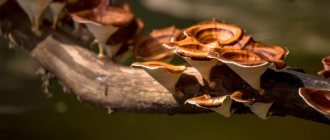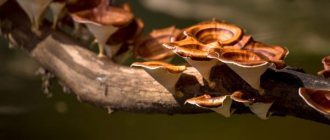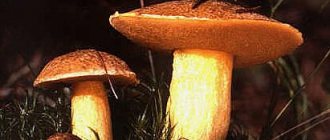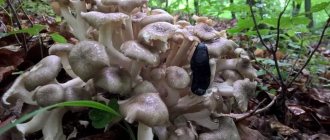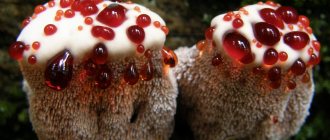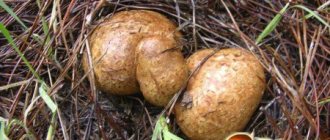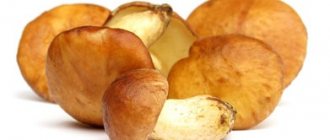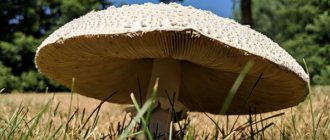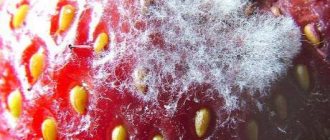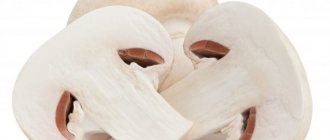Mushrooms
0
1663
Article rating
Kira Stoletova
There is a type of fungi that feeds on dead remains, and there are those that consume the nutrients of living organisms. Saprophytic fungi settle and feed on the remains of animals or plants (scavengers), or excrement.
Description of saprotrophic fungi
Saprophytes
Both bacteria and fungi are saprophytes. Bacteria belonging to this group feed on organic matter from dead organisms. The group of saprotrophs includes lactic acid, soil, butyric acid bacteria and others. This type of fungi includes organisms that develop on humus of plant origin. They can be divided into two groups - edible and inedible.
Suitable for food
Examples of mushrooms that are not harmful to health:
- Champignon;
- raincoats;
- umbrellas;
- morels;
- dung beetles;
- lines (after pre-processing);
- cystoderm;
- cobwebs.
Unfit for food
These organisms should not be eaten:
- pigs;
- Helvelians;
- pale toadstools;
- spring toadstools;
- white toadstools.
How does infection occur?
The source of pathogenic bacteria is contaminated food and water. It is possible for adults and children to become infected from cats and dogs that have had Proteus enteritis. Food products at risk include meat, dairy and fish dishes. Most of the intestinal diseases caused by the activity of Proteus spp. (from 75 to 90%), causes the species Pr. Mirabilis.
Microorganisms belonging to the genus Proteus can also cause diseases of the human excretory and reproductive systems. The appearance of these bacteria can cause symptoms of such diseases in adults and children as prostatitis (both acute and chronic), cystitis, pyelonephritis (in particular, infection with Proteus is the cause of most xanthogranulomatous pyelonephritis). There is also evidence that Pr. Mirabilis is one of the most common causes of wound infections.
Unlike its more aggressive counterpart, Proteus vulgaris is one of the bacteria that is part of the normal intestinal microflora, and is also a saprophyte that feeds on organic debris, lives in the ground, dirty water or manure.
Structure and methods of nutrition
Fungi belong to the species saprophytes or saprotrophs, which form many spores in the process of life. They scatter to surrounding plants or animal remains, facilitating the reproduction and spread of the mycelium. Examples of vegetation that organisms like to settle on:
- cones;
- branches;
- hemp;
- stems of annual grasses;
- needles and foliage;
- feathers and horns.
Different saprophytes or, as they are also called, decomposers, are characterized by different types of substrate on which they settle and feed. So, for the summer honey mushroom, the best food is the remains of deciduous trees. False honey mushrooms feed only on needles. But the white dung beetle miraculously exists in places highly saturated with nitrogen.
Features of treatment
Treatment of infections in adults, children, domestic animals (dogs and cats) caused by microorganisms of the genus Proteus is carried out using antibiotics. The most effective are rifaximin and nifuroxazide. To combat Pr. Mirabilis is prescribed amoxicillin, nifurantel, cephalosporins. The presence of Pr strains should be taken into account. Mirabilis resistant to amoxicillin (also called indole-positive). Treatment of Proteus infections with tetracyclines is ineffective, since all of them are resistant to this antibiotic. But self-medication in such cases is unacceptable; you must consult a specialist.
When treating a child, it is mandatory to prescribe him probiotics. Bacterial preparations, seeding the intestines, create healthy competition for Proteus, causing a gradual decrease in its numbers and restoration of the normal composition of the intestinal microflora. Probiotics are an essential part of the treatment of bacterial infections in adults and children. They are taken on an empty stomach. The duration of the course must be at least 2 weeks.
Symptomatic treatment of Proteus infections in a child consists of prescribing medications that lower the temperature and relieve pain and inflammation.
Treatment of a child necessarily includes a special diet, from which fatty and spicy foods and allergenic foods are excluded. It is useful to give your baby boiled water.
If left untreated, Proteus enteritis can lead to the development of kidney failure in both adults and children.
What types of saprophyte mushrooms are there?
Representatives of the genera Penicillium and Mucor cause food spoilage
The variety of saprophytes is surprising. The names of the most famous:
Mukor: This is a lower mold fungus. Included in the class Zygomycetes. It is aerobic, that is, existence is impossible without oxygen. The mycelium of mucor is unicellular, has many nuclei. All representatives of this genus settle in the upper layers of soil, horse manure, food and organic debris. The body of this organism looks like thin threads - this is a mycelium. On the branches or hyphae of the mycelium, small black heads grow, which contain spores. Mucor feeds on organic matter. The scavenger mushroom, as it is also called, because it does not leave waste. Mucor can also appear on a living, but sick organism. When he dies, all the remains are processed.
Aspergillus: a mold fungus belonging to the higher aerobic species. The genus of these organisms has hundreds of species. All of them are quite common and grow in different climate zones. They take root on various substrates and create fluffy white colonies. But over time the color changes. Aspergillus has strong mycelium and septa. It reproduces, like other saprotrophs, by spores. The organism lives in soil, which contains a lot of oxygen. The organism appears as mold on top of the substrate. This particular mushroom is dangerous. It affects products that contain starch. The organism grows inside and on the surface of the tree.
Irina Selyutina (Biologist):
Fungi of the genus Aspergillus were first described (cataloged) in 1729 by the Italian P. Micheli. Although their natural habitat is the upper soil horizons, especially in southern latitudes, they are most often found on various products, mainly of plant origin. The vegetative body of Aspergillus is a multicellular and very branched mycelium. Mycelial cells are multinucleate. The fungus is characterized by the ability to form aerial mycelium. Representatives of the Aspergillus niger group, which are most actively used in industry and laboratory research, are of greatest practical importance. At one time, the species A. niger was figuratively called “biochemical frog” by L.I. Kursanov. Aspergilli differ from penilla and mucor in that their fruiting filaments at their apex have thickenings with rod-like outgrowths, which in general terms resemble a “shaggy head”. Chains of spores are released from these outgrowths.
Penicillium: these representatives of higher fungi are not uncommon in nature. They belong to imperfect fungi. Of particular value is the green racemose mold - penicillium aureus. The widely known antibiotic penicillin is produced from it. Penicillium lives in the soil. The structure is similar to that of the Aspergillus fungus. The vegetative mycelium is branched, colorless and multicellular. This (structure) of the penicillium fungus differs from mucor - the latter has a protozoan mycelium. The hyphae of the organism are immersed in the substrate or located on its surface. Erect conidiophores form brushes that carry chains of spores. These chains have from one to three tiers and can also be asymmetrical. These fungi reproduce by spores. It is saturated by absorbing organic matter. Some representatives are weak plant parasites. The development of penicillium leads to food spoilage.
Where does dust allergy come from?
Allergies are a result of constant sterilization. People's homes are becoming more and more comfortable - sealed plastic windows, air conditioners, water filters, dishwashers - contribute to the emergence of pathogenic microflora. Synthetic building materials, chemical household detergents, fermented (processed) foods, etc., gradually lead to the accumulation of harmful substances (toxins) in the body and weaken the immune system - the natural protective function of the body. Therefore, as a result, various types of intolerances (all kinds of allergies) appear.
Tick allergy in children can also be provoked by an untreated chronic inflammatory process in the bronchi, which is sometimes confused with bronchial asthma, for which a completely different treatment is prescribed.
(animals and protists) decomposers differ primarily in that they do not leave solid undigested residues (excrement). In ecology, detritivorous animals are traditionally classified as consumers (see, for example, Bigon, Harper, Townsend, 1989). At the same time, all organisms emit carbon dioxide and water, and often other inorganic (ammonia) or simple organic (urea) molecules and thus take part in the destruction (destruction) of organic matter.
What is the difference between saprophytes, symbionts and parasites
There are parasitic, saprophytic and symbiont fungi. The difference lies in the way of eating.
Saprophytes
They prefer substances from dead organisms as a source of food. These are bacteria such as E. coli or certain types of fungi - penicillium. Saprophytes or saprotrophs are a kind of orderlies in nature, because their main function is to process waste.
Symbionts
These are organisms that enter into symbiosis with other species and receive mutual or unilateral benefits from this. Not only aquatic, but also land organisms participate in such relationships. Symbionts create beneficial relationships with each other, with fungi, bacteria and multicellular organisms. But the number of algae susceptible to symbiosis is small.
Parasites
They exist at the expense of living organisms, feeding on their living flesh. Parasites spend almost their entire life in the host’s body. They not only reduce the amount of nutrients, but also poison the carrier organism (host).
It is interesting that pathogenic fungi also lead a saprophytic and parasitic lifestyle. These microorganisms of diverse origin live in different places and conditions. Such organisms play an important role in science, so they are specially grown in an artificial environment for study. The following types of environment are distinguished:
- Non-selective: the most popular type for is Sabouraud agar. It is high in carbohydrates. Often the environment is modified by adding antibiotics, cycloheximide or chlorhexidine. And also to isolate fastidious pathogens, the medium is enriched with 5–10% CA, adding heart and brain extract.
- Selective: such a medium is prepared from a non-selective substrate by adding penicillin, streptomycin and chloramphenicol.
Main groups of saprotrophs
Mushrooms
Of all the saprotrophs, fungi are among the most efficient at breaking down complex organic molecules and recycling these nutrients back into the ecosystem. Fungi are the main decomposers of plant matter, which makes up the vast majority of detritus on Earth.
The bulk of plant tissue is made up of a complex carbohydrate called cellulose. Cellulose is made up of many glucose molecules arranged in such a way that most organisms are unable to efficiently metabolize the compound. Fungi, however, have evolved a set of enzymes that allow them to digest complex structures, converting fiber into simple carbohydrates. This ability plays a critical role in the carbon cycle, allowing the release of carbon dioxide from decaying organisms, and converting plant tissue into substances that both fungi and other living things can use for nutrition.
Fungi that decompose leaves and twigs on the forest floor include mushrooms of the genus Marasmius and many familiar garden or forest species. Fungi such as Pilobolus feed primarily on the excrement of herbivores. Wood-decaying fungal species, including Trametes, Pleurotus, and Ganoderma, can have negative economic impacts on the forest industry by decomposing both cut wood and dead bark from living trees. Damage to people's homes is caused by the real house mushroom, or weeping serpula (Serpula lacrymans).
Bacteria
Escherichia coli Bacteria are
well known decomposers of dead animal flesh and are effective at converting animal tissue into simpler forms of organic compounds. A number of saprotrophic bacteria, including E. coli, are associated with diseases of the digestive system, since meat and other foods are also their source of nutrition in nature.
Some bacteria, such as Spirochaeta cytophaga, have the ability to degrade cellulose. Symbiotic cellulose-decomposing bacteria are found in the rumen of cows and aid in animal digestion through the fermentation of cellulose in grass. Like fungi, these organisms also have the ability to partially break down cellulose into intermediate molecules and facilitate its decomposition process.
Oomycetes
Insect larva (mayfly) infected with an oomycete. Photo: TheAlphaWolf / Wikimedia Commons
Oomycetes are a clade of mycelial organisms distributed in freshwater and marine habitats throughout the world. Some species, especially those from the order Saprolegniales, are saprotrophs and decompose both plant and animal material. These organisms are considered to be among the most important decomposers in freshwater ecosystems.
Didn't find what you were looking for? Use the site search form
Did you like the article? Leave a comment and share with your friends
This is interesting: Land resources of the Earth
Physiology of fungi
Two groups can be distinguished:
- Fungi choose living plants or producers for their existence. These fungi feed on living plant cells. They do not grow on artificial soil.
- Fungi live on plant remains or decaying organic matter. But there are few such representatives; basically, these organisms can move from one phase to another.
Thus, autumn honey fungus is a saprophyte and develops on dead stumps. It happens that it grows on living trees, and in such conditions it becomes a parasite. But parasitic tinder fungi, living on living plants, are occasionally found on dead parts of the tree. There are known cases where fungi at different stages can behave both as saprophytes and as parasites. And even a typical parasite can be grown in an artificial nutrient soil called agar.
Reproduction
This parasitic fungus can reproduce both asexually and sexually. This fact makes it very tenacious, quickly spreading in nature and dangerous.
How does it reproduce?
In primarily asexual reproduction, mucor reproduces through spores. Threads emerge from the mycelium, which at the end have black heads with seeds. When the spores ripen, the head bursts under the influence of dampness and heat and they are carried by the wind over long distances throughout the area. If conditions are favorable, mold attaches and germinates, forming a mycelium.
During sexual reproduction, two branches of mycelia merge and form a diploid zygote. In humid and warm conditions it germinates into a hypha. The sporangium is born on the hypha.
